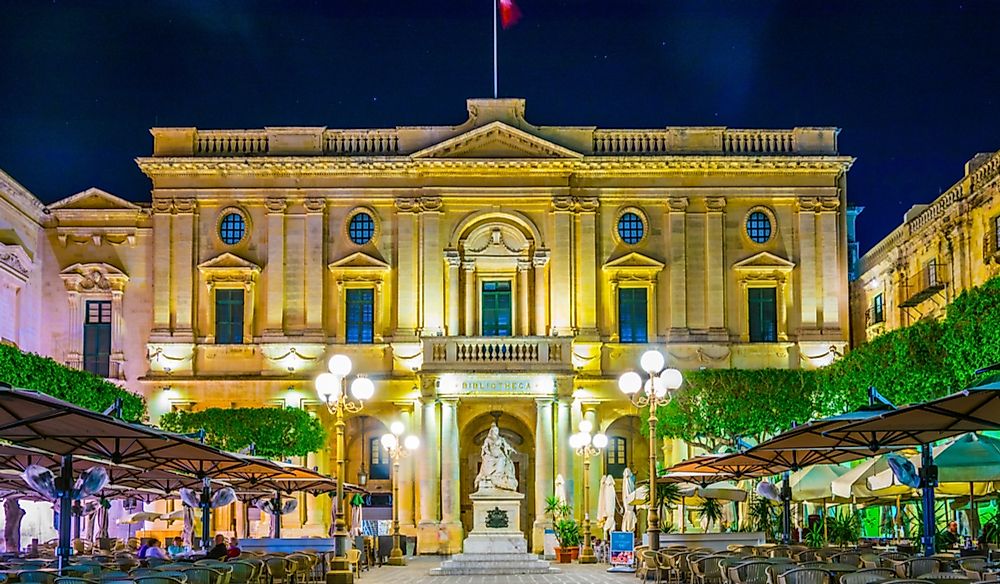The Culture Of Malta

Malta is a Southern European Mediterranean island country. Cultures of neighboring Mediterranean nations, as well as that of the nations that ruled over the islands, have helped shape the Maltese culture.
6. Ethnicity, Language, and Religion in Malta
The islands of Malta together host a population of around 449,043 individuals. Ethnic Maltese constitute the vast majority of the population. They are the descendants of the ancient Phoenicians and Carthaginians and exhibit traits of Italian and other Mediterranean peoples. Maltese and English are the official languages of the country. The former is spoken by 90.1% of the population. Roman Catholicism, the state religion of Malta, is the religion of over 90% of the population.
5. Maltese Cuisine
The cuisine of Malta is strongly influenced by a variety of foreign cuisines, especially Italian and English cuisines. A significant volume of the food consumed in the country is imported. The fenek (traditional Maltese stewed rabbit) is often regarded as the national dish of Malta. Pork is used in various Maltese dishes like kawlata (a vegetable soup) and ross il-forn (baked rice). Gozo, an island in the Maltese archipelago, is well known for its distinct dishes. The Gozitan cheeselet is particularly famous. Fish, stewed snails, stuffed artichokes, fritters, etc., are also part of the traditional Maltese cuisine.
4. Literature and the Arts in Malta
The production of literary works in the Maltese language gained momentum in the 20th century. Prior to that, the languages of the ruling powers predominated in the archipelago. Initially Latin, and then Italian, French, and English were used for official documentation and correspondence in the country. It was only in 1936 that Maltese was recognized as the official language of Malta. The earliest literary text in the Maltese language is the poem Il-Kantilena written by Pietru Caxaro. It was written in the 15th century. The first epic poem in the language was Il-Ġifen Tork. It was published in 1842. The People's History of Malta, the first history book in the language was published in 1862. The first novel in Maltese, Elvira, or the Love of a Tyrant, was printed in 1863.
Malta has a rich heritage of visual arts that reflects the influences of the various foreign powers that ruled the country from time to time. Today, Malta also has a thriving contemporary art scene. The Maltese city of Valletta was designated as the European Capital of Culture for 2018. Maltese lacework and filigree are important crafts of the country.
3. Performance Arts in Malta
The music of Malta covers a range of genres like metal, electronica, folk music, etc. Ghana is the traditional music form of the country. Maltese singers have participated in several Eurovision Song contests and some have won awards at the contest. Malta also has numerous theaters that host live performances.
Despite the traditional conservatism prevailing in the country, Malta has a vibrant nightlife. Clubbing and pub-crawling are popular among Maltese youth and tourists. DJ music is often played out in the clubs which frequently have large outdoor patios.
2. Sports in Malta
Football (soccer) is the most popular sport in Malta. The Maltese avidly follow the Italian and English matches and support either of the foreign teams. When their favorite team wins, the Maltese respond with great joy and hold boisterous street parties. Malta also has its own national football team that is yet to make a mark in international football. Boċċi is another popular game played in Malta. It is a local variety of bocce (a ball sport belonging to the boules family). The Maltese also have a great passion for waterpolo. Horse racing has a long tradition in the country.
1. Life in the Maltese Society
Today, both men and women enjoy equal rights and freedoms in the Maltese society. However, traditionally, married women were expected to stay at home and manage the household and children while men were regarded as the breadwinners. Although a large section of Maltese women in the 21st century are well-educated and employed, some traditional duties are still associated assigned to them by society. Working women expected to cook and perform other household chores. In some families, however, men do participate in these tasks and childcare activities.
Traditionally, marriages in Malta have been based on status considerations and family prestige. However, today many marriages are based just on romantic relationships. Divorce was illegal in the country until 2011. Now, same-sex marriages have also been legalized.
The Maltese are quite religious in nature. Christening of infants takes place in church and godparents are chosen during the ceremony. Women generally engage more in child-rearing than men. The Maltese attend Church quite regularly. Top-class education for children is a priority for most parents. Sex is a taboo topic and courtship prior to adulthood is not encouraged. The Maltese tend to be reserved in nature. Modest dressing is preferred.











